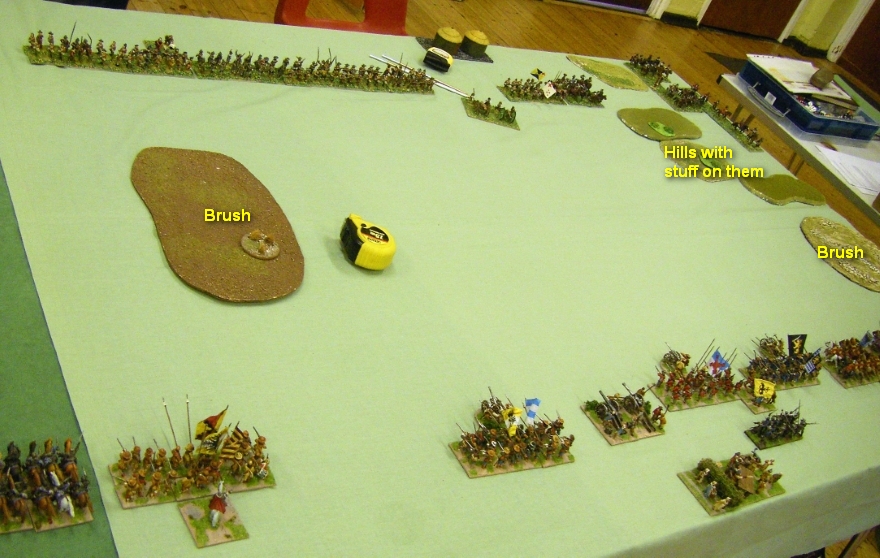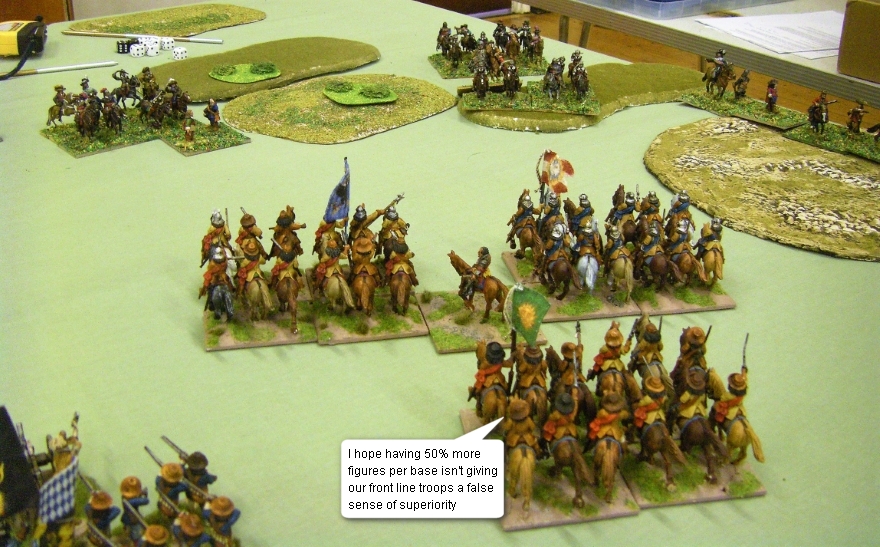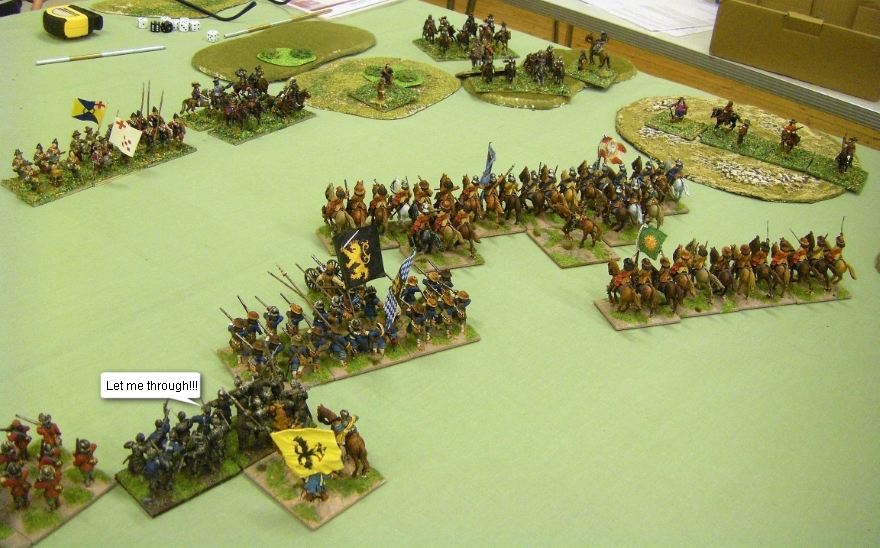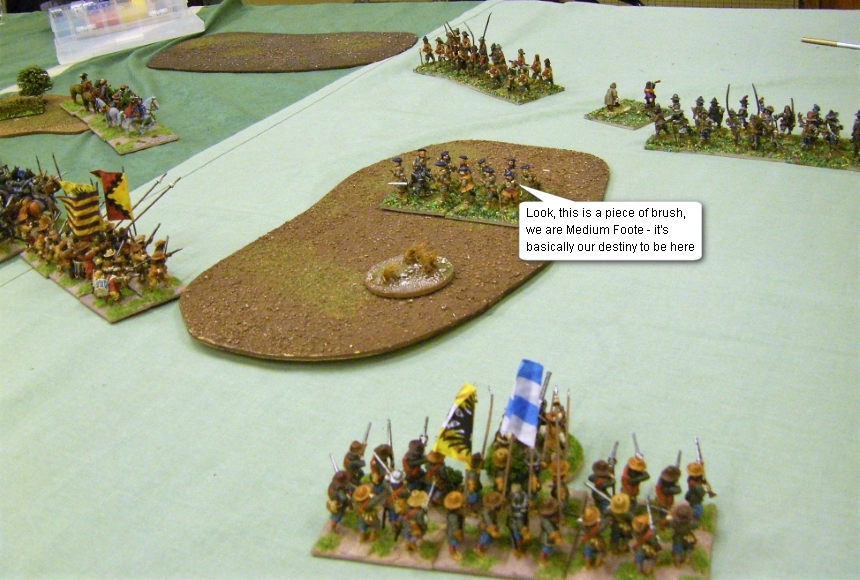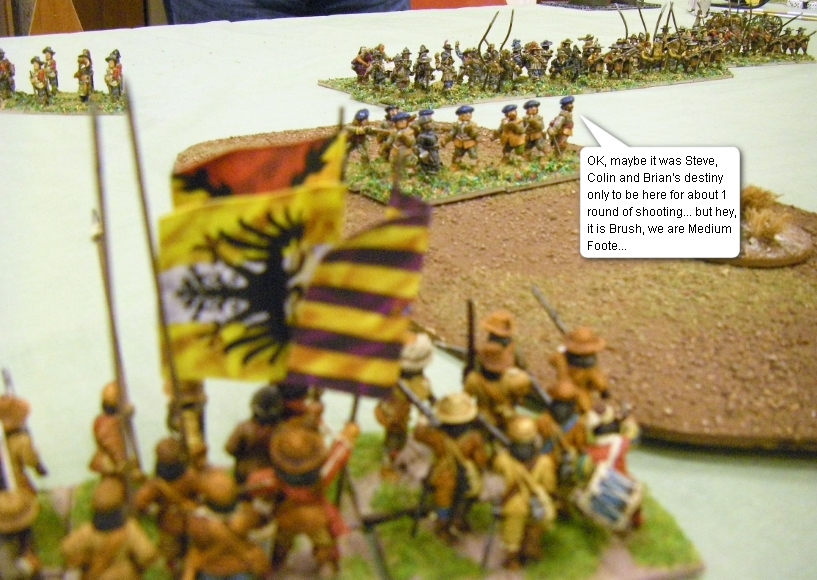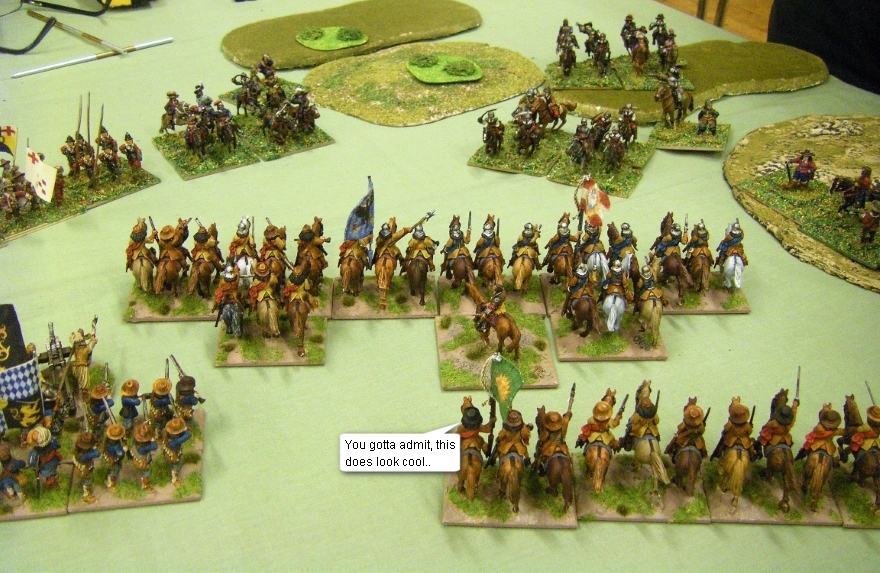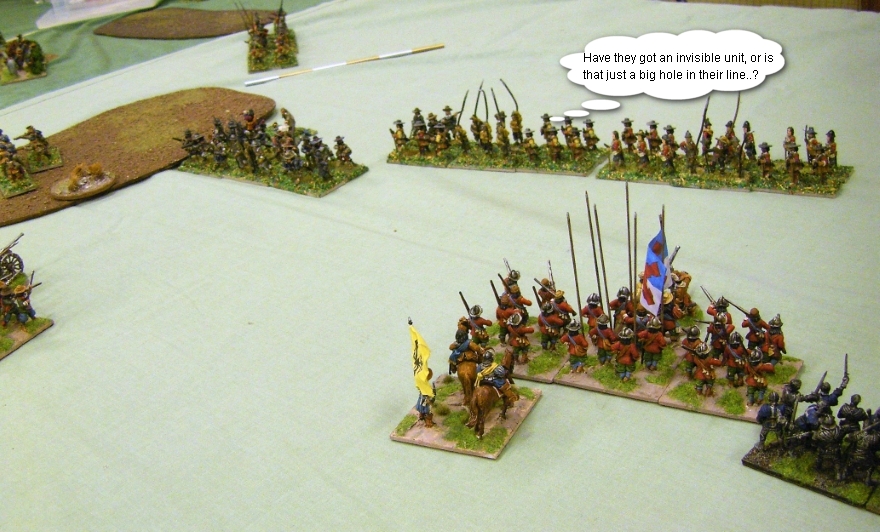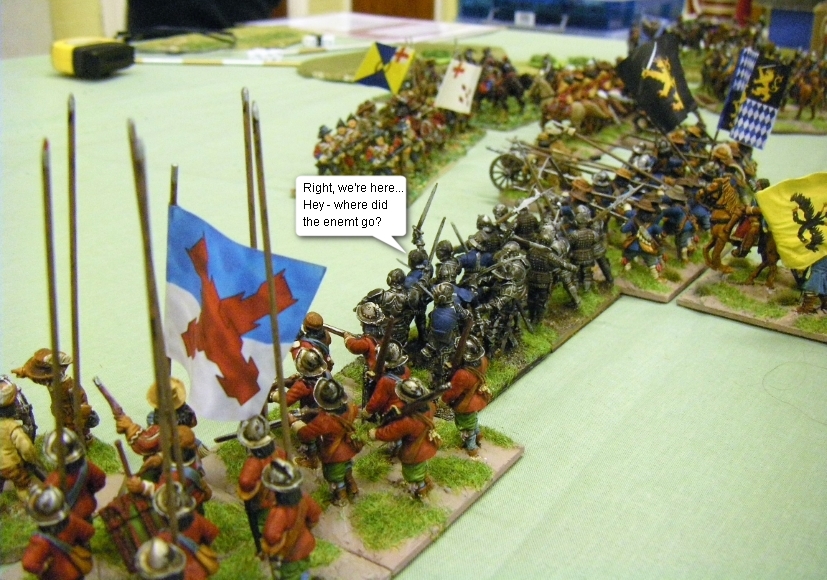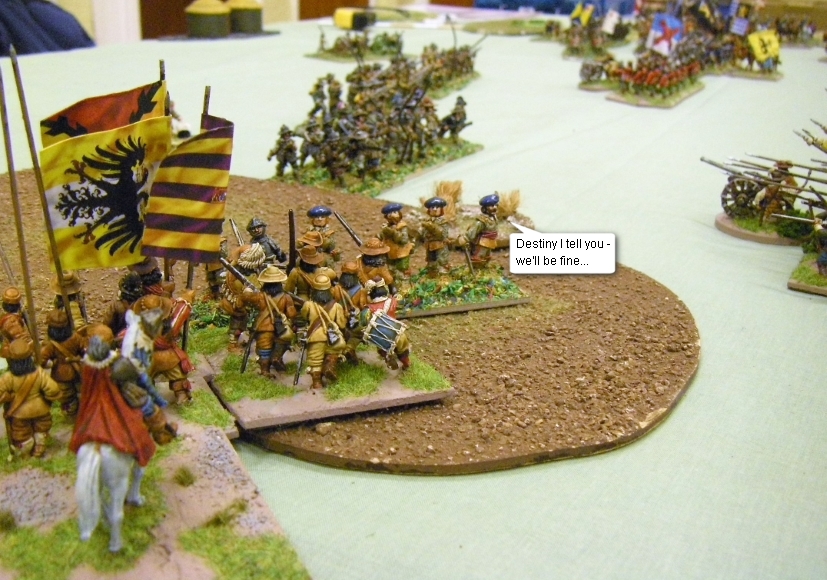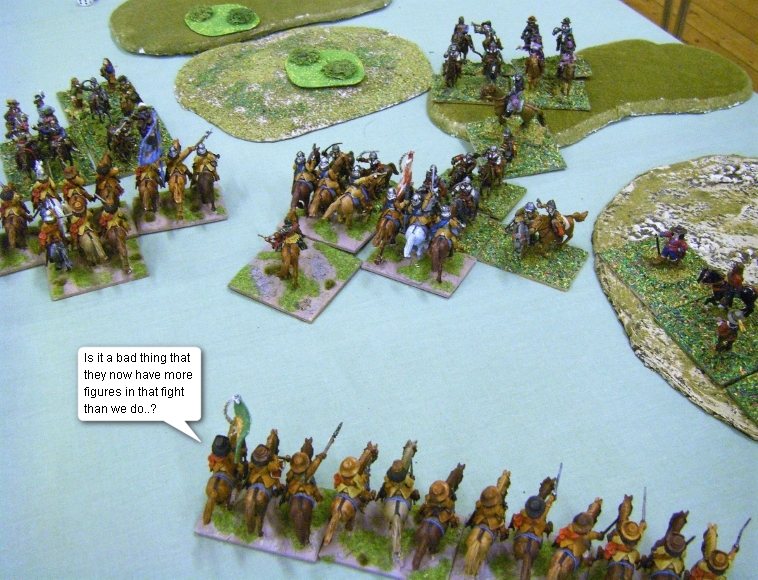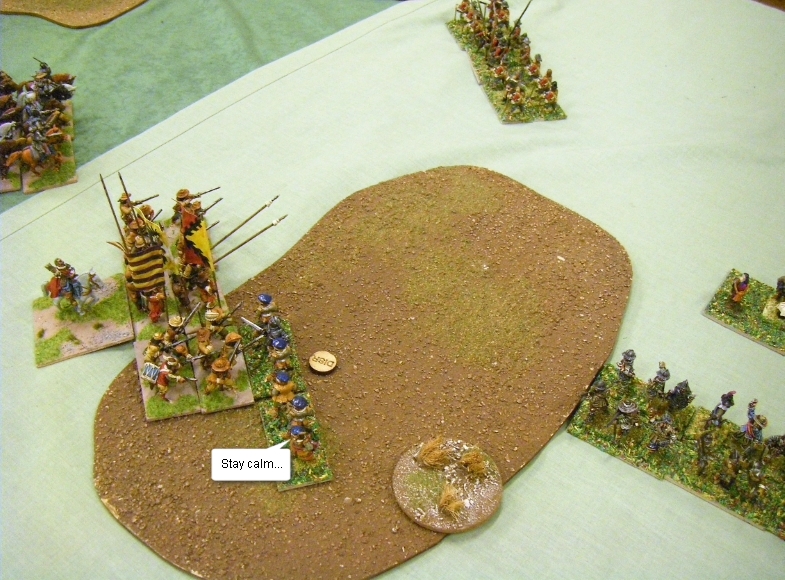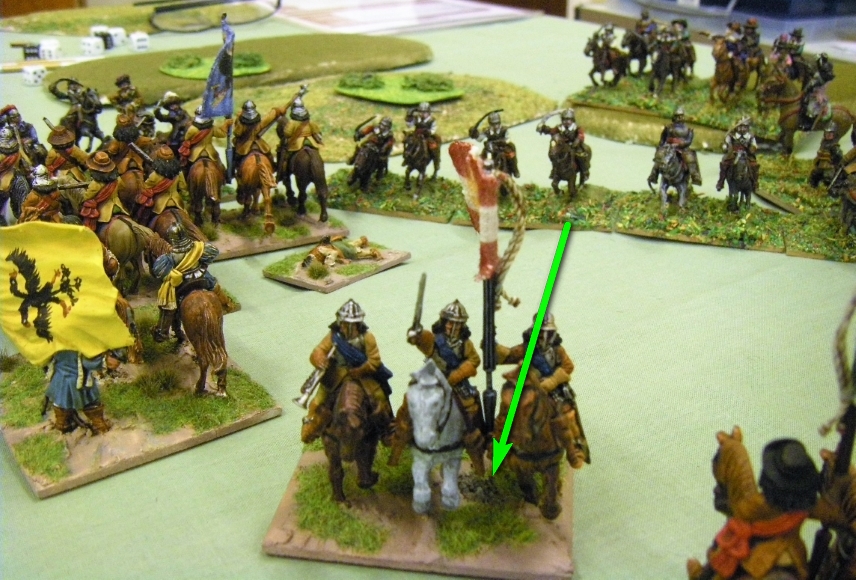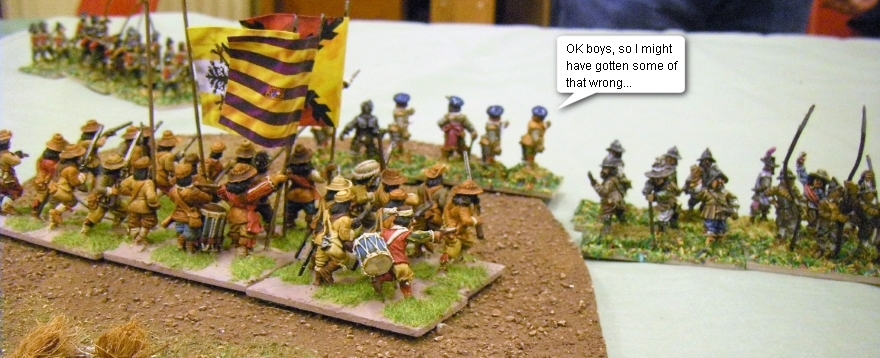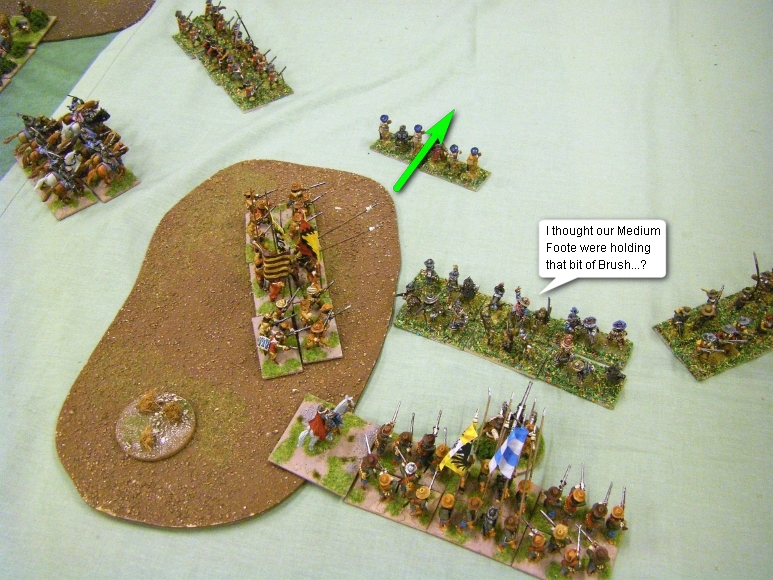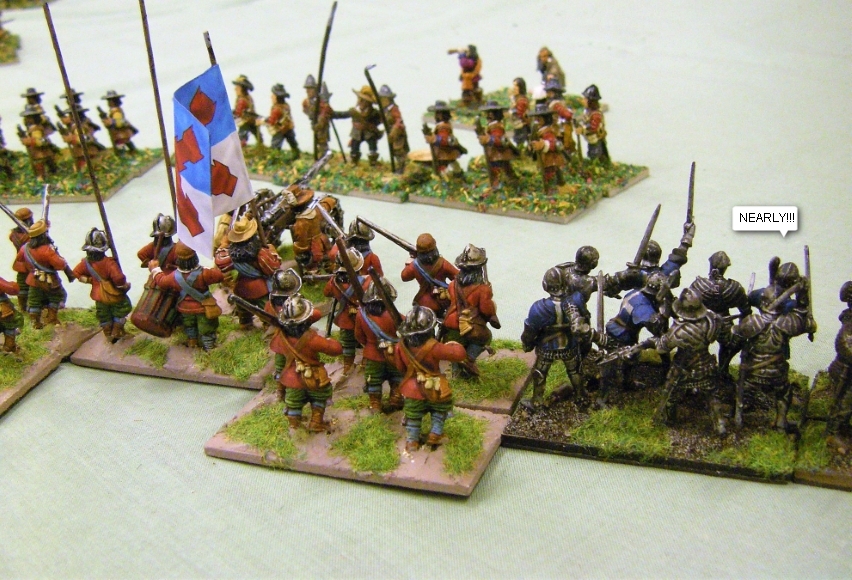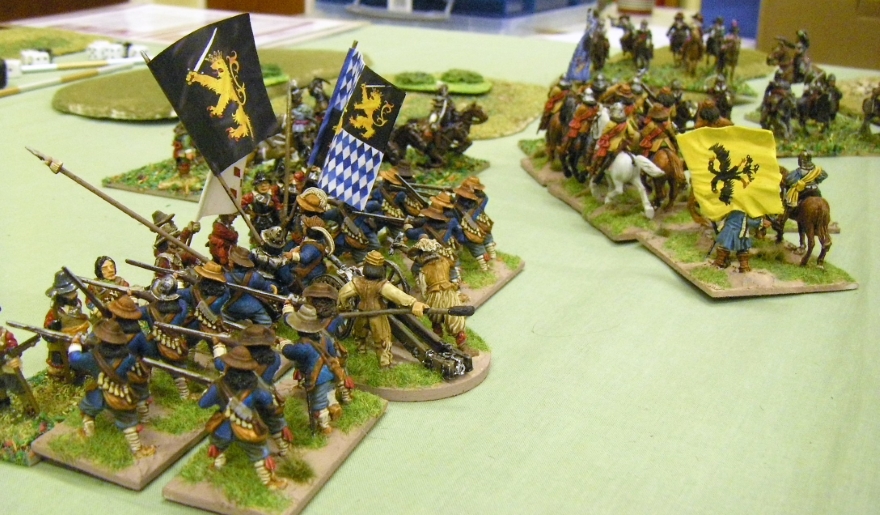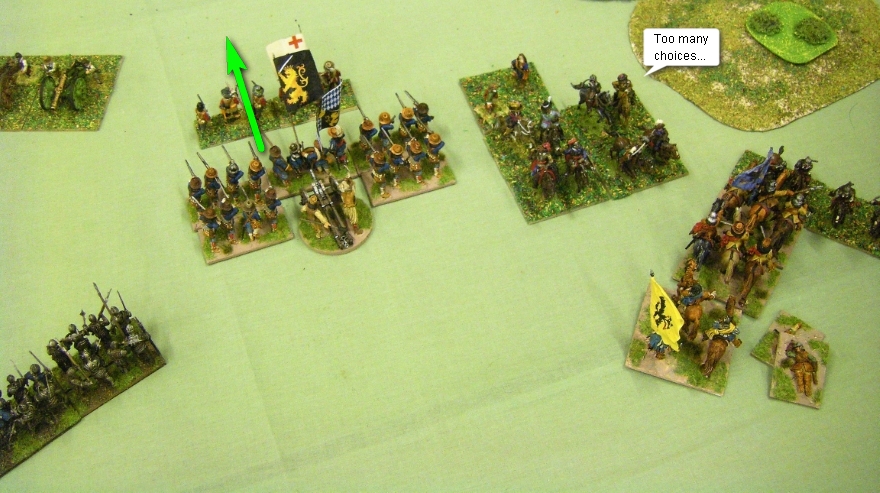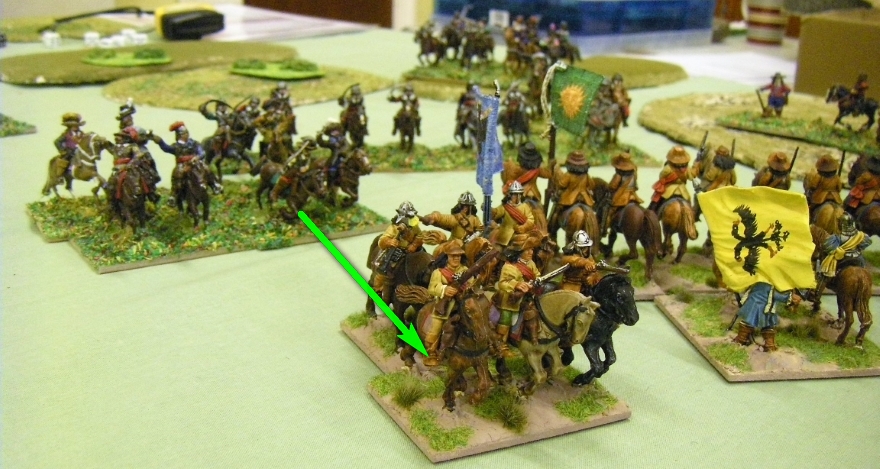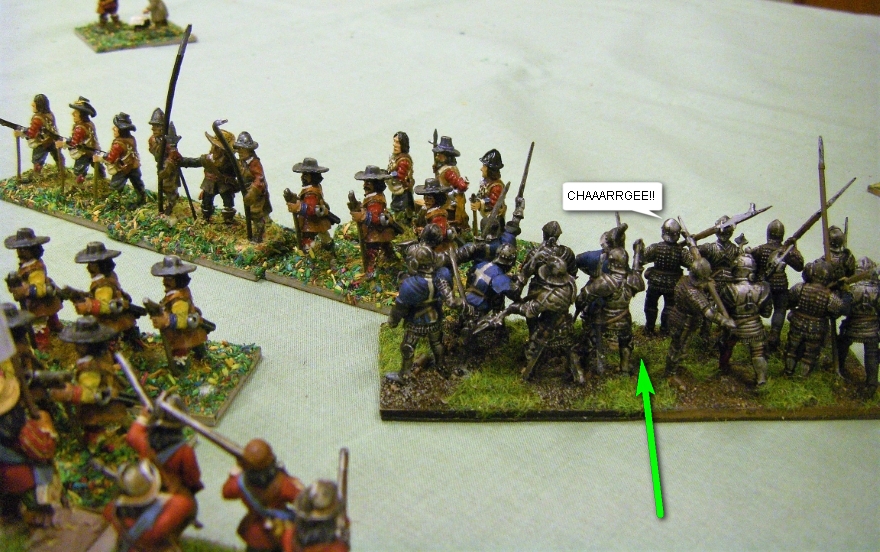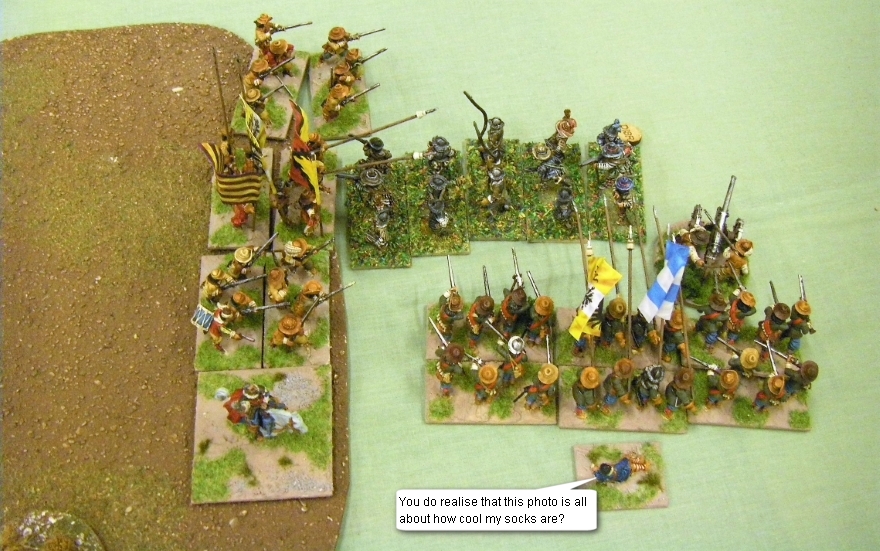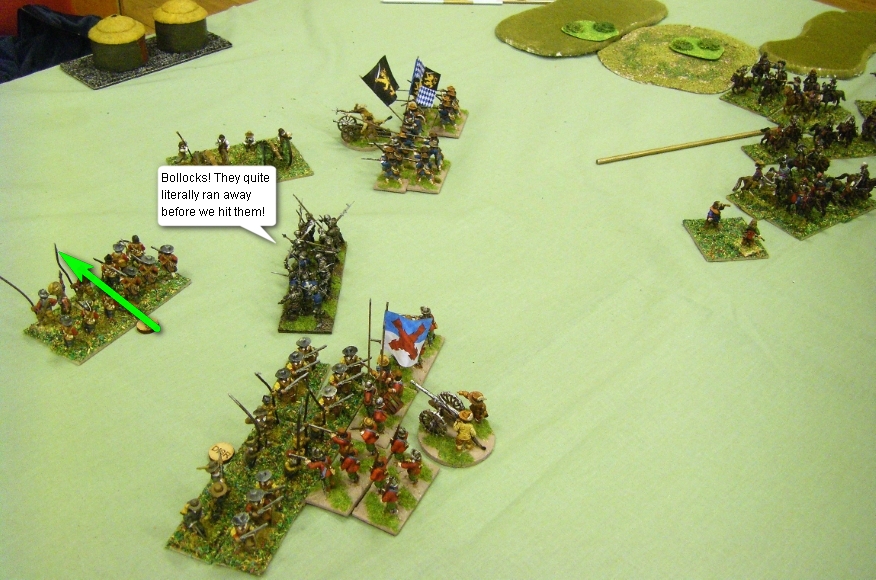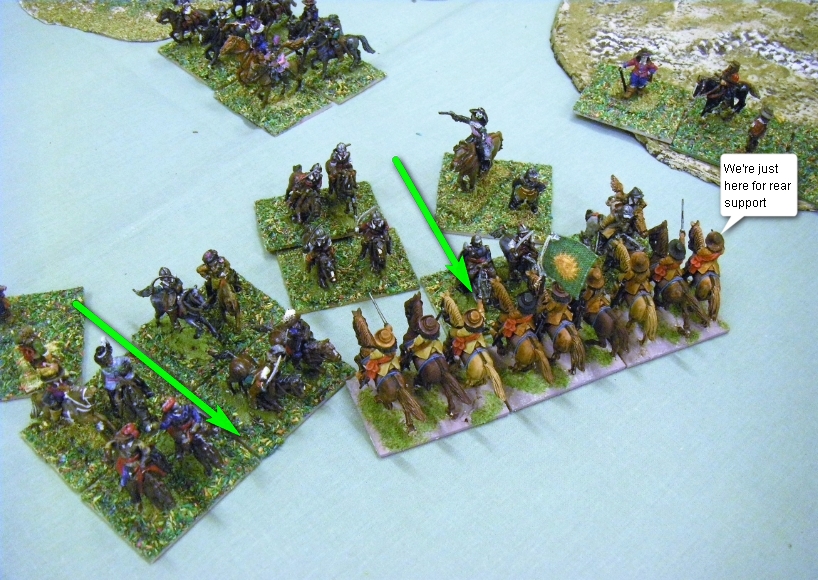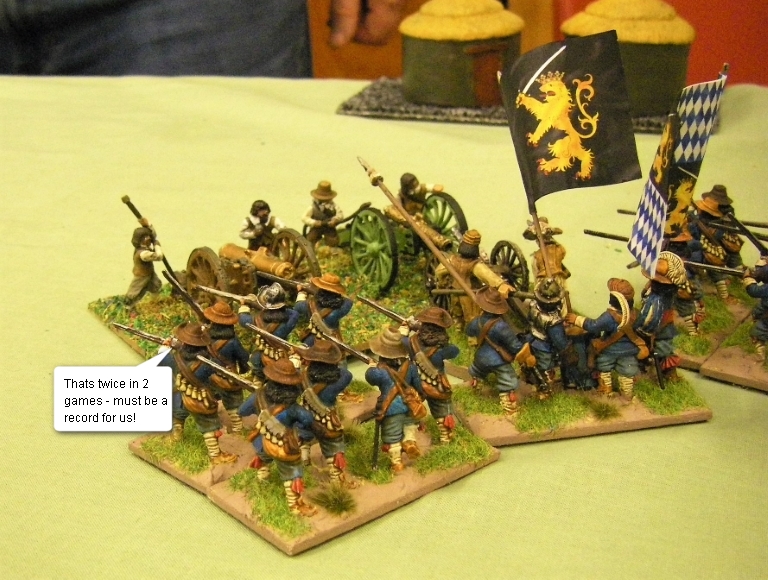Thirty Years War in Oxford 2018
TYW German vs New Model Army
Game 1 TYW German vs TYW Swedes
Game 2 TYW German vs New Model Army
Game 3 TYW German vs Italian Wars French
With a surprisingly victorious game against the Swedish steamroller under my defiantly C17th belt, the second game snuck into view just before a normal lunchtime against one of the oher choices I had considered - the New Model Army of Oliver Cromwell from the ECW. Given the Oxfordshire location, this would mark a high watermark of offensive operations for the Lincolnshire and Rutland yellowbellies ... and also a first time they engaged in the continental struggle of the TYW as well.
The lists for the TYW German and New Model Army from this game, as well as all the other lists from the games at Oxford can be seen here in the FoG:R Wiki.
What was already a more open battlefield than the first had been further cleared by both parties moving terrain to the extremities. This left the field dominated by one large patch of rough ground, with a complex mess of gentle hills and unever areas on the German right.
Faced with such an open plain even the mounted vastness of the German list construction had some interesting challenges to confront - a conundrum which they chose to answer with a heavily mounted-stacked right wing and somewhat of a tokenistic force on the left astride the terrain.
The expectation had been that the Parliamentarians would go big on the infantry part of their force, and would not enjoy such decent numbers of offensive Horse as the flower of the Rhine. This however proved to be somewhat of a miscalculation as (save for the puritan economic thriftiness of having but 2 horse figures per base to our 3) the English had a well stocked horse-pantry full of mounted men all of whom were seemingly committed to the same wing as the Germans own horseback schwerpunkt.
Only the terrain was constricting the NMA's advance, and faced with this the German riposte ws to rush forward and try and bottle up Cromwells enthusiastic Ironsides for as long as possible.
The New Model Army's elite troops were its Regiments of Horse. They were armed and equipped in the style known at the time as harquebusiers, rather than as heavily armoured cuirassiers. They wore a back-and-front breastplate over a buff leather coat, which itself gave some protection against sword cuts, and normally a "lobster-tailed pot" helmet with a movable three-barred visor, and a bridle gauntlet on the left hand.
The sleeves of the buff coats were often decorated with strips of braid, which may have been arranged in a regimental pattern. Leather "bucket-topped" riding boots gave some protection to the legs. Regiments were organised into six troops, of one hundred troopers plus officers, non-commissioned officers and specialists (drummers, farriers etc.). Each troop had its own standard, 2 feet (61 cm) square.
The huge numbers of mounted troops on the English side had in turn left their infantry centre less well tooled up than expected - several units of Pike and Shotte were strung out across the table, seemingly undecided as to advance to support their Horse or sit back and exchange cannonade fire with the German line.
Seeing an opportunity for the Little Gunnes and Superior Quality of the 2 German 'colour' regiments on this side of the board to press the advantage the German commander ordered a general advance, dragging infantry to support his already battle-deplyed mounted formation and put pressure on the heart of the English line.
Even the Tortoisiers appears to have found a useful battlefield role this time - marching into space to try and end up as an overlap in a mythical future combat scenario.
FoGR hint - The Tartischiers are armed only with Swords, so will not do well in Impact against almost anyone with a pointy stick and a gung-ho attitude. In melee their heavy armour can work unless they are fighting shotte (who ignore it), but where they may in theory come into their own is acting as an overlap to proer fighting troops. Here their Sword skills give them a ++ when fighting from overlap - also presumably avoiding any nasty Impact phase confontation in the process
Cromwell's men had also decided - almost inevitably - that the large patch of rough going was the ideal place to put their all-Medium foot Firelock unit.
Admittedly uneven ground could do very bad things to close formation pikemen, but even so the scots-bonnetted 4-strong unit was still comfortably within range of German infantry muskets shooting into the terrain from both sides - aided of course by their Little Gunnes.
The rest of the Parliamentarian army meanwhile seemed reluctant to commit themselves to helping out their little (and exposed) friends.
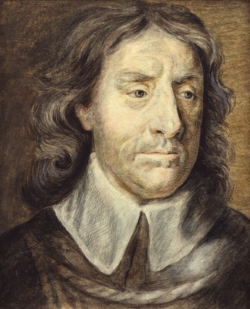
Inevitably the efficiency of Prussian sharpshooting (and a bucket of dice rolls) had it's way with the box-shaped 2x2 perfection of the Firelock unit, and they were reduced in short order to 3/4 of their original strength.
The opportunity to occupy terrain had - as it so often does - created naught but a target for the opposition to aim their fire at.
New Model Army - No Rest (1985)
The New Model Horse were by now starting to boil out of the gap between the hillsides like rats from a rapidly filling sewer, and with Parliamentarian dragoons also sniping into the flanks of the German demi-Cuirassiers the pressure to initiate a decisive clash of equals on horseback was mounting with every passing turn.
The New Model Army contained one regiment of dragoons, of twelve companies each of one hundred men, under Colonel John Okey. They were armed with flintlock "snaphaunces" rather than the matchlock muskets carried by the infantry. On the battlefield, their major function was to clear enemy musketeers from in front of their main position. At the Battle of Naseby, they were used to outflank enemy cavalry.
In 1650, Okey's dragoons were converted into a regiment of horse
The German optimism as to the outcome took something of a nosedive however after realising that the NMA Horse were in fact also "Determined", rather than the straight "Horse" they had mistakenly believed them to be from the start of the game. This was now all about luck...
Spurred on by the sight of a stonking great gap in the middle of the German line which had developed as the German foote drifted right to support theior Horse, the NMA infantry regiments in the centre of their line now also sprang forwards.
University of London - 3 minute summary of the New Model Army
If the Germans could keep the combats and shooting one-on-one their better technology and Little Guns should see them come out on top - but the advantage of an extra full unit of Pike and Shotte was potentially considerable for the Parliamentarian cause at this juncture too.
With their well designed and highly engineered flags fluttering efficiently in the Oxfordshire breeze (somone must have opened the door to go out for a smoke maybe?) the German army lined up to see if it could get the Tartuschierists into action as their German gods had intended - overlapping something, anything.
Basically, as long as they didn't really need to fight proper troops with guns they'd be just fine ...

With the Firelocks now down to 2 bases and the main Parliamentarian line advancing on the denuded German centre, the German unit to the left of the terrain piece decided that shooting was just too boring and that they needed instead to be pressing into the flanks of the advancing enemy Pike and Shotte to properly support their colleagues in the centre.
The 6-pack wobbled slowly over the broken ground and launched a charge against the already battered remnants of the Firelock storming party, expecting to evaporate them with sheer weight of combat dice and then follow up and pursue straight through the terrain to appear with gusto on the flanks of the advancing men of Norfolk and Kesteven
Hooves rumbled imperiously across the battlefield, and breatplates echoed to the sounds of pistol-shot bouncing against rolled steel as the two lines of Determined Horse smashed into one another at close range. The German's had - of course - planned and prepared better and had already extended out ito a coherent line to give extra width and overlaps after the first round Impact clash, but the Parliamentarians had also prepared well.
Their skill was not in the dark but important arts of military planning, but in smiting righteous blows against the infelelious and perfidious Catholics of the Crown, and they were seemingly able to transfer this fury and skill into this battle too as they devastated the Germans at contact, hammering the mounted formation for no real losses of their own.
The German second line would seemingly be called into action sooner rather than later...
On the battlefield, a regiment of The New Model Army's Horse was normally formed as two "divisions" of three troops, one commanded by the regiment's colonel (or the major, if the colonel was not present), the other by the lieutenant colonel.
Their discipline was markedly superior to that of their Royalist counterparts. Cromwell specifically forbade his men to gallop after a fleeing enemy, but demanded they hold the battlefield. This meant that the New Model cavalry could charge, break an enemy force, regroup and charge again at another objective. On the other hand, when required to pursue, they did so relentlessly, not breaking ranks to loot abandoned enemy baggage as Royalist horse often did
This was rapidly turning out to be one of those turns where Things Don't Go Right for the German army. The seemingly simple task of sweeping away the last of the Firelocks had turned into an irritating and protracted slog as the men with no Pikes to call their own refused to melt away into the scrubby undergrowth and yield ground to superior numbers.
Instead they put up a dogged resistance, clearly aware of the vital role they were now playing in protecting the flank of their advancing force of infantry who were even now barrelling down the centre of the table towards the open heart of the German army.
The first round of the Horse contest was over, and Oliver's Army had chalked up a decisive victory by destroying the very best elements of the German mounted formation in the shortest possible time.
The sole survivor fled back towards the walled cities and sausage-festooned brauhauses of Lower Saxony at an impressive rate of knots as the somewhat stunned but now increasingly confident Ironsides looked around for their next victims.
Ironside's Theme Tune
Finally! The Firelock infantry break and run from the terrain in the face of overwhelming numbers of Germans assaulting them (OK, it was from failing 3 cohesin tests and the final base never got removed but... they all count).
The Germans pick their way slowly and carefully through the potholes and badger setts of the blok-shaped area of uneven ground and appear as if by magic and surprise on the flanks of the Parliamentarias at the exact same moment they themselves are considering piling into the isolated German regiment occupying the centre of the table.
In the nick of time indeed...
The new Model Army's Regiments of Foot consisted of ten companies, in which musketeers and pikemen were mixed, at least on the march. Seven companies consisted of one hundred soldiers, plus officers, specialists and so on, and were commanded by captains. The other three companies were nominally commanded by the regiment's colonel, lieutenant colonel and major, and were stronger (200, 160 and 140 ordinary soldiers respectively). Each company had its own standard, 6 feet (180 cm) square.
The colonel's company's standard was plain, the lieutenant colonel's had a cross of Saint George in the upper corner nearest the staff, the major's had a "flame" issuing from the cross, and the captains' standards had increasing numbers of heraldic decorations, such as roundels or crosses to indicate their seniority.
The New Model Army always had two musketeers for each pikeman though depictions of battles show them present in equal numbers
Donnerwetter! Suddenly fighting spreads down the whole line like wildfire as the two sides come to grips in both mounted and pedestrian incarnations. Superior German foote hammer home against less robust Englishmen as the reserve echelons of German cavalry are thrown unexpectedly into the fray against still-fresh Ironsides in a display of colour and violence never before seen on the plains of Merrey Olde England
The plan to despatch the Firelocks with combat rather than shooting was now starting to emerge in its full glory, much to the chagrin of the NMA infantry regiment which now found itself surrounded by the prompt arrival of a full-blown German formation on it's left wing.
A bemused English foote regiment had been left out of the battle on the extreme right of Cromwells' line by this move but instead of swinging into the terrain themselves to create a domino effect of threatened flanks they were being kept extremely honest by the Cuirassiers who extended the German left wing.
Taking down the New Model Foote frontally was almost certainly beyond the Cuirassiers, but ensuring they didn't advance in such a way which would require them to expose their flank to the fully-clad horsemen was much more a straightforward task, and one the Cuirassiers applied themselves to with some keeness
The NMA's regiments of foot were provided with red coats - red was chosen because uniforms were purchased competitively from the lowest bidder, and Venetian red was the least expensive dye. Those used by the various regiments were distinguished by differently coloured linings, which showed at the collar and ends of the sleeves, and generally matched the colours of the regimental and company standards. In time, they became the official "facing" colour.
On some occasions, regiments were referred to, for example, as the "blue" regiment or the "white" regiment from these colours, though in formal correspondence they were referred to by the name of their colonel.
The Germans pressed forward along the line, using their Little Gunne shooting to devastate the formerly solid line of Parliamentarian troops, rendering them potentially easy targets for a decisive short and bloody charge.
Ich glaub mich knutscht ein Elch! The anachronistic Tartuschiers meanwhile were secretly praying for the Puritan soldiers to stand up and roll good dice, as only by surviving the upcoming Impact phase would the Englishmen still be there when the sword at overlap factors would at last come into play
Ich glaub mich knutscht ein Elch! For every "colour" regiment pressing home the German's advantage over the Parliamentarian pedestrians, there was a unit of Ironsides giving the Prussian Horsemen a right good spanking with a rolled up newspaper.
The German Horse were seemingly unable to remember that the whole army had been designed with the aim of them winning the battle with a rousing charge and noisesome battle cry to the sound of accompanying trumpets and instead were picking every opportunity possible to lose against near-identical enemy mounted troopers.
Would the Germans be able to punch their infantry regiments through Cromwell's midriff, or would their two-headed-eagle's wings collapse in a flurry of feathers to leave their infantry overrun by Ironsides?
Charles arrested - Harry Potter vs Star Wars!
Mist! Taking the story of the last block of text and dialling it up to 11 the Blue German regiment breaks and routs its opponent and presses on towards the English gunnes whilst Cromwell's indomitable Ironsides do likewise with the second wave of German demi-Cuirassiers, sweeping forward to where the already-committed German reserve line of Horse are making very heavy going of standing up to their frontal opponents
Painting Warlord Games Bluecoated infantry
Autsch! The Germans again break and flee in dissarray - a whole plan, and several weekend's of painstakingly assembling and painting 28mm cavalry lies in tatters, undone and unhorsed by the righteous fury of the puritanical martial spirits of the pride of Britain!
The Puritans - and Blackadder
As the lines of soldiery start to disentegrate and fragment, the well-armoured Truffelistiers suddenly see an opportunity they are both enthused and frightened by in equal measure. A now-Fragmented enemy infantry units sits before them,. but to get to grips they will need to brave a first round of charging home.
The Germans are in two minds - do they want the glory of defeating the enemy in hand to hand combat, or the efficiency and personal safety of just seeing them break and flee at the moment they try and charge them through failing a 3rd reaction test?
On the opposite flank the Germans are putting excessive amounts of pressure on the increasingly isolated and disparate NMA infantry. Having succesfully (and eventually...) navigated their way through the terrain and disposed of the Firelock party a German Regiment opts to slam into the flank of the Brits, while their colleagues dither to their front, unable to decide if charging this wide open goal is in fact something they want to do in their already 1-cohesion-marker-festooned state. Zum Teufel!
The Cromwellian horse are now pursuing freely on their left, having totally overwhelmed the German's supposedly potent mounted wing in fairly short order.
But, in being crushed, the horsemen from North Rhein-Westphalia have at least bought time and space for their much better infantry to pile on the shooting and pile on the hurt to the New Model Foote across a broad swathe of the centre of the field. Genau!
With their infantry evaporating before them, the English Gunnes are now also in severe danger of being captured by the advancing Germans who's mastery of the shooting phase of the game has allowed them to destroy the English with relatively few casulaties so far.
Heiliger Strohsack! With victory seemingly almost within the grasp now of the German army, their least enthusiastic infantry unit continued to refuse to stick the ball into the back of the net when facing an open goal. Quite happy to sit and shoot at the exposed rear ranks of the enemy formation, charging home and sweeping them away had remained out of their graps... but now a Fragged marker was on the table it surely would become much easier to close out the game?
Even the best players sometimes miss a sitter...
Zur Hölle damit! The Ironsides had by now realised that the game was almost up for their dispersed and largely demoralised army. They concentrated on mopping up the last few remnants of the German demi-Cuirassiers in an effort to leave their side of the table tidy and free of teutonic obstacles, even if their pedestrian co-soldiers were having a more torrid time of things practically everywhere else.
The Blue Coated German regiment waving their Bavarian flags in the air truimphantly sweep forward and overrun the Parliamentarian artillery park to ratchet up the vital final damege points needed to tip the game in favour of de Manschaft. The result is a decisive 20-5 victory for the TYW German army!
Click here for the report of the next game in this competition, or read on for the post match summaries from the Generals involved, as well as another episode of legendary expert analysis from Hannibal
Post Match Summary from the TYW German Commander
 This was most certainly a game, and one in which we efficiently and effectively executed a well thought out plan in a way which maximised involvement of a cooperative of the management team and the workforce to create a positively well built victory machine which then drove down the autobahn of success a high speed until it reached its multi-syllabilic desitination.
This was most certainly a game, and one in which we efficiently and effectively executed a well thought out plan in a way which maximised involvement of a cooperative of the management team and the workforce to create a positively well built victory machine which then drove down the autobahn of success a high speed until it reached its multi-syllabilic desitination.
Simple concentration of force on the individual components of the British machine was the foundation for the groundwork of victory. It was as if the British believed that they had a stronger position each time that one of their units advanced and isolated itself in an attempt to negotiate vistory against the not-quite-27 concerted members of my force.
As well as this there were refusals of flank, threats of charges to keep the opposition fixated in place, and almost an important role in victory for the Tartuschierists as well and their heavy plate armour and longswords.
Truly this was progress to victory through superior technology.
Hannibal's Post Match Analysis
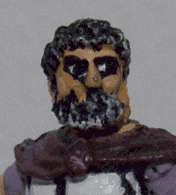 Luck spews out of the very ground you walk upon, and yet you still manage to look like a man who's pants have been doused in heating oil and who's tailor is a part time fire juggler. Quite how this can lead to a second victory remains beyond me by some margin.
Luck spews out of the very ground you walk upon, and yet you still manage to look like a man who's pants have been doused in heating oil and who's tailor is a part time fire juggler. Quite how this can lead to a second victory remains beyond me by some margin.
Yet again your supposedly superior mounted forces allowed themselves to be overrun by identical or even worse quality troops, and yet again it was the lack of supporting shooting capability which undid them as they took casulaties of their own before the enemy horsemen even got close enough to think about charging what was by then inferior numbers. Combined arms does not mean you need to hold them up and surrender to the opponents shooting from both guns and muskets.
At least your infantry game was on point, even though it took you much of the game to spot the opportunity which presented itself to you to apply superior numbers of better quality and better equipped troops against the enemy line.
I wonder with fear and trepidation what will be in store for you in the next game
Click here for the report of the next game in this competition
You may also like....
Game 1 TYW German vs TYW Swedes
Game 2 TYW German vs New Model Army
Game 3 TYW German vs Italian Wars French
View My Stats for My Match Reports Pages


